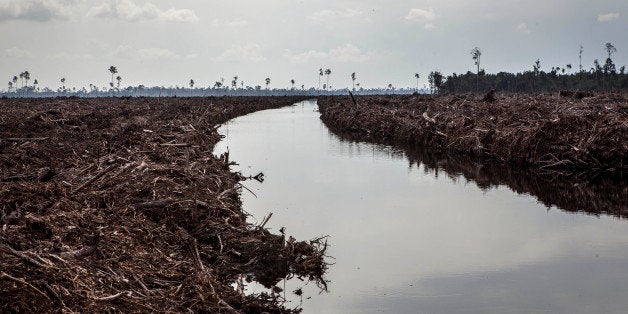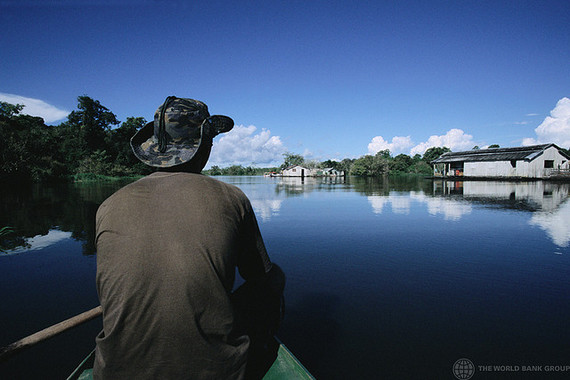

A fisherman goes out in search of Piranha on Lake Iranduba, in the Amazon region of Brazil, near Manaus. Brazil. Photo: © Julio Pantoja / World Bank
Spanning 2.7 million square miles and standing 80 percent intact, the Amazon forest endures as arguably the apex of Mother Nature's works of wonder. Remnants of other forests remind us of what could happen to the Amazon if uncontrolled deforestation were to be left unchecked. The once vast and luxuriant Brazilian Atlantic forest, for example, is now reduced to 8 percent of its original extent, lingering on as a pale shadow, many of its unique species and indigenous cultures now long gone. More than 12 times the size of France, the Amazon contains the greatest concentration of plants, animals and microorganisms that evolution has ever assembled.
Having resisting large-scale transformation at the hands of humans for over 500 years, the Amazon today faces unprecedented road, energy and mining development that is starting to threaten the ability of the forest to continue providing ecosystem services at the local, regional and global scales. Alarmingly, recent research suggests that even incremental deforestation may be sufficient to push the Amazon beyond a tipping point where forests could give way to drier and more fire-prone vegetation. This phenomenon has been coined as the "Amazon Dieback," the subject highlighted in a recent World Bank report.
A few years ago, I commissioned a study from my colleague Dr. Tim Killeen on the mounting threats to the region resulting from rapid economic development, particularly triggered by new road construction. Killeen insightfully titled the study, "A Perfect Storm in the Amazon Wilderness." At the eye of the storm is the Transoceanic Highway linking the Pacific coast of Peru to the Brazilian Amazon, and from there to the Atlantic coast. The highway traverses one of the most biodiverse portions of the Peruvian and Brazilian Amazon.
Nothing is as threatening to forests as roads, and the access to the interior turned previously uneconomical activities into highly profitable ones. And the "perfect storm" described by Killeen may lead to a transgression of forest cover thresholds considered safe to the integrity of the ecosystem.
If we reach a tipping point, many things could happen, virtually all of them bad for the health of the planet. First, the Amazon would start releasing carbon stored in forests into the atmosphere, adding to other sources of emissions that are destabilizing the global climate. Second, hydrological flows would be disrupted, triggering more frequent and more severe droughts across the region and well beyond, including the United States, Europe and Asia. The famous "flying rivers" of the Amazon -- massive humid air currents -- would start to dry up, adding to global warming. Finally, the cumulative impact of changes of this magnitude would trigger mass extinction of species in the world's biologically richest ecosystem. These are not scenarios worth betting against with a laissez faire approach.
Short of the tipping point, not all scenarios for the Amazon run counter to the long-term prospects for the sustainability of the region provided certain promising measures continue to be implemented, adjusted or expanded. The recent trajectory of the Brazilian Amazon offers important insights. Brazil holds 60 percent of the basin and has historically experienced the largest share of deforestation. But through better management, Brazil has also dramatically reduced the rate of forest cover loss during the past decade. From a peak of 11,000 square miles in 2004, annual deforestation has dropped by 79 percent, to a record low of 2,260 square miles in 2013. The government has committed to a target of keeping this number below 1,300 square miles by 2020.
According to recent studies, these accomplishments have so far been translated into 3.2 gigatons of CO2 that did not rise into the atmosphere through deforestation, equivalent to avoiding one full year of all global emissions of CO2. This was accomplished through a series of tools that include the expansion of the Brazilian Amazon's protected areas system and securing the land rights of indigenous peoples. Brazil has also followed up with enforcement of laws banning unauthorized deforestation, deploying modern remote sensing techniques along with public pressure on producers, wholesalers, and retailers of commodities associated with deforestation, such as soy and beef. While not perfect, the combination of these mechanisms is making a significant difference in reducing deforestation.
A single initiative funded by the Global Environment Facility (GEF) and other donors, and implemented by the World Bank -- the Amazon Region Protected Areas project, or ARPA for short -- took some 93,000 square miles out of the speculative land grabbing market, the key entry point for deforestation. ARPA thereby effectively voided any expectations of future tenure for cattle ranching or plantations in an area comparable to the state of Michigan.
Today, nearly half of the Brazilian Amazon has come under protection in parks, reserves or indigenous lands, a tremendous achievement by any measure. While further incremental expansion of protected areas is still possible, there are signs that this window of opportunity is closing fast because of fast rising costs of securing and maintaining additional land.
As the region becomes economically integrated across country borders, its future will be progressively dependent on what happens to the unprotected half of this vast territory. While the growth rate of the Brazilian population has dropped to 1.86 children per woman, largely as a result of rapid urbanization, in the Amazon is still growing at a 2.42 rate.
Therefore, other economic uses of the forest must be rapidly developed, tested and scaled-up. These include putting into practice the concept of sustainable forest management that seeks to enhance the economic, social, and environmental value of all types of forests by building on the multiple benefits they provide. Many important discussions are currently taking place to start laying the foundations for a sustainable development model for the Amazon in the years and decades to come. The GEF will be at the table along with our partners to help build and implement this next step to secure Nature's single most important gift to humanity. I will report periodically on these ideas and plans.
